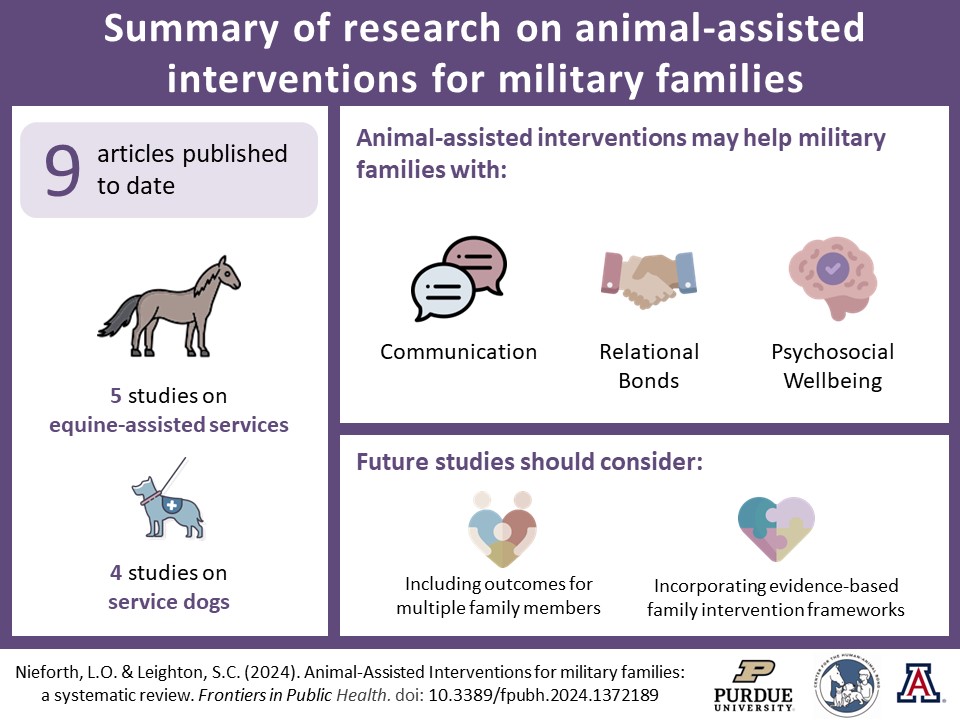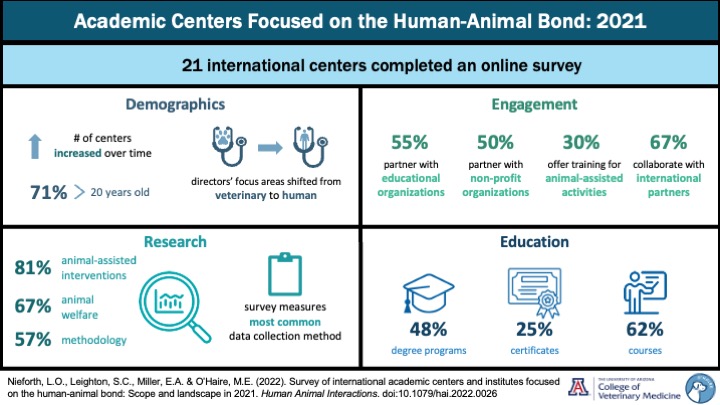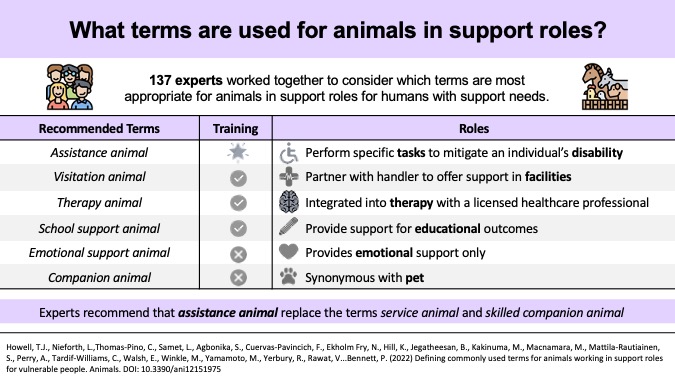
General Human-Animal Interaction
Human-animal interaction (HAI) is a broad term encompassing the interactions between people and animals, and the physical, social, and psychological outcomes of those interactions (Hosey & Melfi, 2014). These interactions may be unplanned, such as human-wildlife interactions, or intentional, such as human-companion animal interactions, humans partnering with service animals, or interactions via animal-assisted services, which are treatment, education, and/or support programs where one or more individuals interact with an animal as guided by a qualified professional (Binder et al., 2024). Animal-assisted services are one way that humans can benefit from HAI; research has demonstrated numerous benefits of human-animal interactions, including companionship, emotional and social support, decreased loneliness, lowered anxiety levels, and better mental and physical health (Fine et al., 2025). While much of the research in the human-animal interaction field focuses on human-canine and human-equine interactions, other species have also been incorporated into studies, such as cats, chickens, dolphins, and guinea pigs (e.g. McDonagh et al., 2019; Vitale et al., 2022; Wirth et al., 2020; Yerbury & Boyd, 2018). Research into human-animal interactions allows us to better understand the influence humans have on animals, and animals have on humans, paving the way for more effective, healthy, and supportive human-animal relationships.
Our Research

Show full text description
Summary of research on animal-assisted interventions for military families
Publications
A total of 9 articles on animal-assisted interventions for military families have been published to date. Of these, 5 studies focused on equine-assisted services, and 4 studies focused on service dogs.
Findings
Animal-assisted interventions may help military families by improving:
- Communication
- Relational bonds
- Psychosocial wellbeing
Recommendations for Future Research
- Include outcomes that represent multiple family members
- Incorporate evidence-based family intervention frameworks to strengthen program design and evaluation
This systematic review highlights that animal-assisted services offer potential for supporting family functioning and emotional wellbeing in military populations.
Nieforth, L.O. & Leighton, S.C. (2024). Animal-Assisted Interventions for Military Families:
A Systematic Review. Frontiers in Public Health. doi:10.3389/fpubh.2024.1372189

Show full text description
Animal Assisted Interventions (AAI) for Autism Research: 2015–2020
Field Growth
The field of animal-assisted interventions for autism research has doubled in size over the past five years. A total of 43 new studies were published between 2015 and 2020.
- 75% of the studies were quantitative.
Study Characteristics
The average dosage across studies was 12 sessions, each lasting about 1 hour.
The most common animals used in interventions were:
- Horses (50%)
- Dogs (42%)
Findings and Methodology
- The most common outcome measured was social interaction (44% of studies).
- No studies reported a decline in participant functioning.
- Methodological rigor remains an issue: 47% of studies lacked a control condition.
Overall, the research shows growing evidence for the benefits of animal-assisted interventions for autism, but highlights the need for more rigorous study designs.
Nieforth, L.O., Schwichtenberg, A.J. & O’Haire, M.E. (2023). Animal assisted interventions for autism spectrum disorder: A systematic review of the literature from 2016-2020. Review Journal of Autism and Developmental Disorders. doi: 10.1007/s40489-021-00291-6

Show full text description
Academic Centers Focused on the Human-Animal Bond: 2021
Overview
A total of 21 international centers completed an online survey examining academic focus areas related to the human-animal bond.
Demographics
- 71% of centers are more than 20 years old.
- The number of centers has increased over time.
- Directors’ focus areas have shifted from veterinary to human domains.
Engagement
- 55% partner with educational organizations.
- 50% partner with non-profit organizations.
- 30% offer training for animal-assisted activities.
- 67% collaborate with international partners.
Research
- 81% focus on animal-assisted interventions.
- 67% study animal welfare.
- 57% focus on research methodology.
- Survey measures were the most common data collection method.
Education
- 48% offer degree programs.
- 25% offer certificates.
- 62% offer courses.
Overall, academic centers dedicated to the human-animal bond demonstrate a growing international presence with multidisciplinary engagement and educational offerings.
Nieforth, L.O., Leighton, S.C., Miller, E.A. & O’Haire, M.E. (2022). Survey of international academic centers and institutes focused on human-animal bond: Scope and landscape in 2021. Human Animal Interactions. doi:10.1079/hai.2022.0026

Show full text description
Researcher–Practitioner Collaboration Focused on Human–Animal Interaction
A Model for Healthy Partnerships
The study proposes a framework for building successful collaborations between researchers and practitioners in the human–animal interaction field. Key elements include:
- Building understanding
- Aligning needs
- Launching research
- Project management
- Following through
- Inspiring one another
Recommendations for Constructive Communication
Effective communication within partnerships should address:
- Terminology and shared definitions
- Interpretations and theoretical frameworks
- Standards and branding consistency
Partnering to Elevate Best Practices
- Adhering to industry standards
- Maintaining detailed reporting
- Protecting participant confidentiality
The collaboration model emphasizes mutual respect, transparent communication, and shared responsibility as the foundation for advancing the human–animal interaction field.
Leighton, S.C., Nieforth, L.O., Griffin, T.C., O’Haire, M.E. (2022). Researcher-practitioner interaction: collaboration to advance the field of human-animal interaction. Human-Animal Interactions. doi:10.1079/hai.2022.0025

Show full text description
What Terms Are Used for Animals in Support Roles?
Overview
A panel of 137 experts collaborated to identify the most appropriate terminology for animals in support roles assisting humans with various needs.
Recommended Terms and Definitions
| Recommended Term | Training Required | Role Description |
|---|---|---|
| Assistance animal | ✔️ | Performs specific tasks to mitigate an individual’s disability. |
| Visitation animal | ❌ | Partners with a handler to offer support in facilities. |
| Therapy animal | ✔️ | Participates in therapy with a licensed healthcare professional. |
| School support animal | ❌ | Provides support for educational outcomes. |
| Emotional support animal | ❌ | Provides emotional support only. |
| Companion animal | ❌ | Generally synonymous with pet. |
Key Recommendation
Experts recommend that the term assistance animal replace the terms service animal and skilled companion animal to create consistency across contexts.
Howell, T.J., Nieforth, L.,Thomas-Pino, C., Samet, L., Agbonika, S., Cuervas-Pavincich, F., Ekholm Fry, N., Hill, K., Jegatheesan, B., Kakinuma, M., Macnamara, M., Mattila-Rautiainen, S., Perry, A., Tardif-Williams, C., Walsh, E., Winkle, M., Yamamoto, M., Yerbury, R., Rawat, V…Bennett, P. (2022) Defining commonly used terms for animals working in support roles for vulnerable people. Animals. doi: 10.3390/ani12151975

Show full text description
Pets May Play an Important Role in Helping Us Through the COVID-19 Pandemic
Overview
This infographic summarizes findings from Purdue University’s Center for the Human–Animal Bond regarding how pets may help people manage uncertainty and stress caused by the COVID-19 pandemic.
Key Insights
- COVID-19 has created uncertainty worldwide and is projected to trigger posttraumatic stress symptoms for many individuals.
- Managing uncertainty is important to reduce lasting effects from a traumatic experience.
- Pets may provide social support that helps people cope when human social support is limited or unavailable.
The study highlights the potential role of companion animals in fostering emotional stability and resilience during times of crisis and isolation.
Nieforth, L.O. & O’Haire, M.E. (2020). The role of pets in managing uncertainty from COVID-19. Psychological Trauma: Theory, Research, Practice, and Policy. doi: 10.1037/tra0000678

